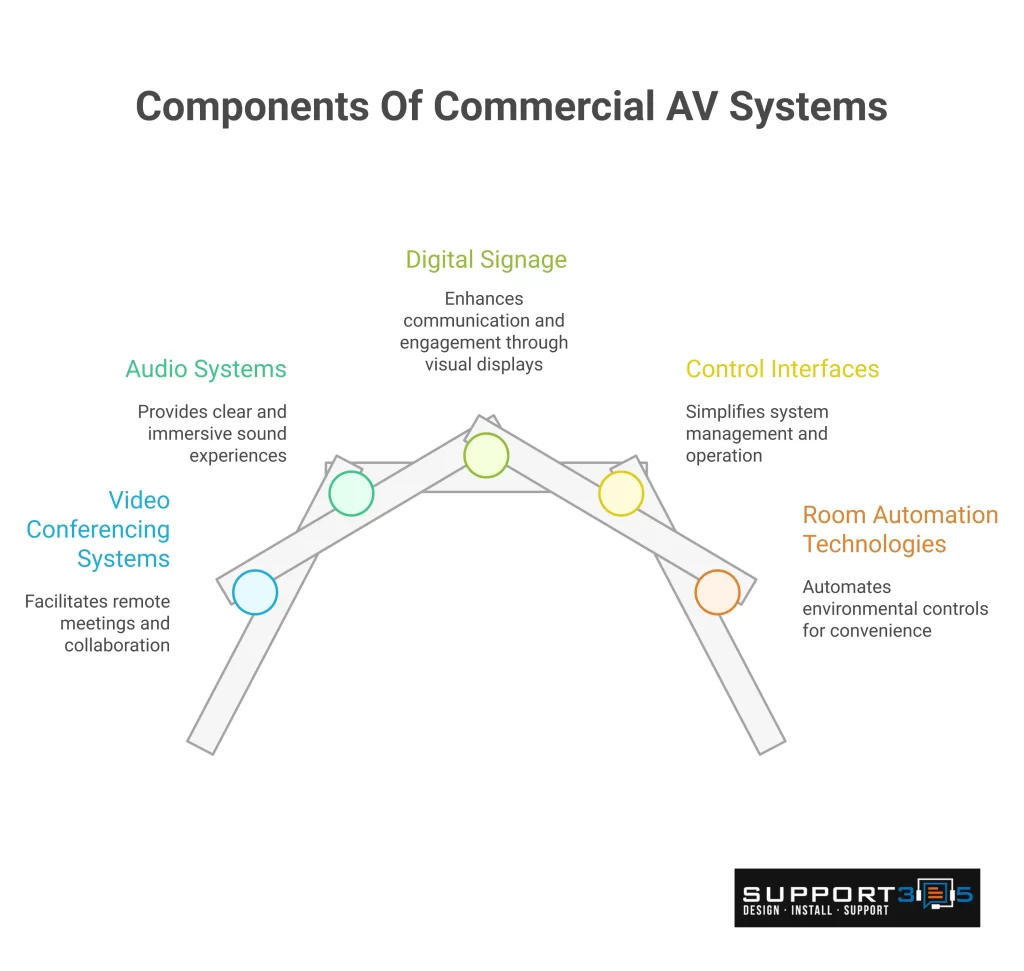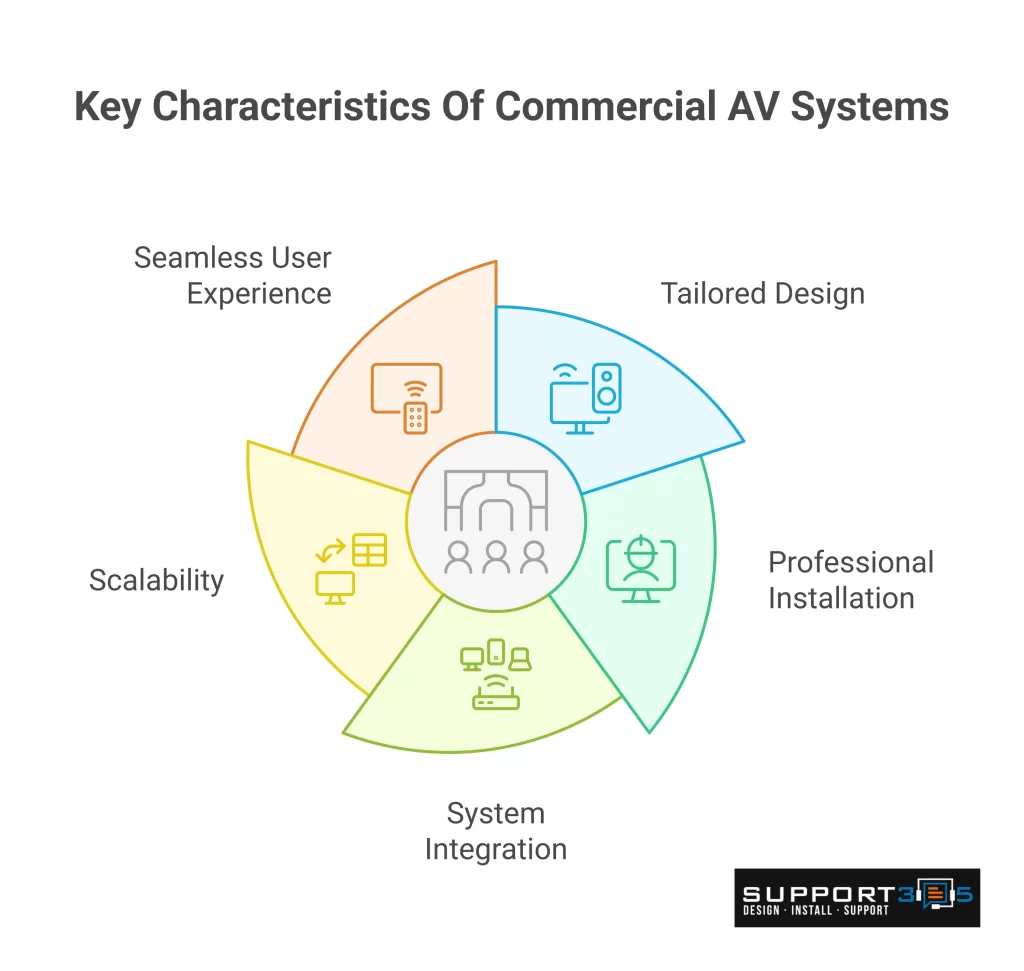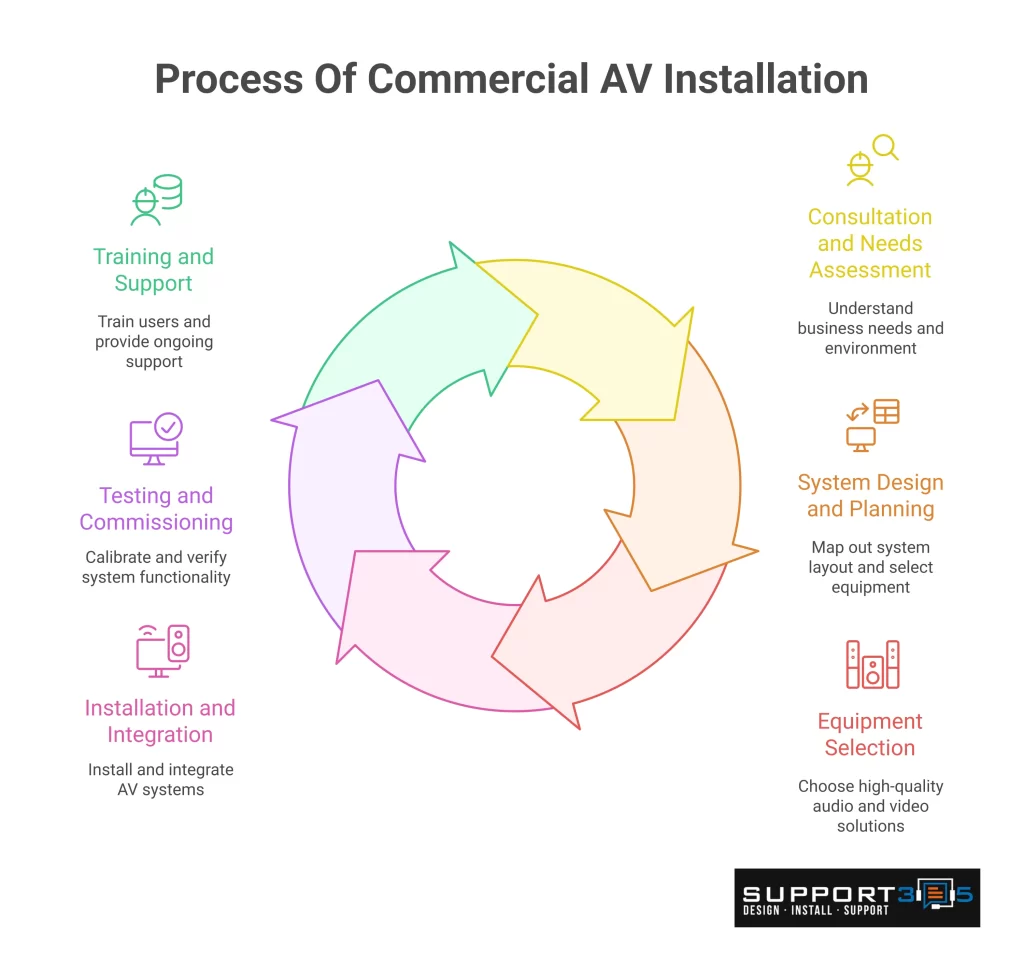Commercial AV systems play a vital role in modern business environments, enhancing communication, collaboration, and customer experiences. This article explores what commercial AV installation entails, how it differs from residential setups, the benefits it offers, and the types of systems available. It also covers the installation process, wiring, safety standards, scalability, and how to choose the right AV partner—ensuring your business is equipped with reliable and future-ready audiovisual solutions.
Content
What is Commercial AV Installation?

Commercial AV installation refers to the structured process of designing, setting up, and integrating audio-visual (AV) systems within commercial environments to support seamless communication, collaboration, and presentation needs. Often referred to as audio video installation, this process is essential for ensuring reliable, high-performance systems that meet the demands of modern businesses. These solutions are critical across industries like corporate offices, hospitality, education, healthcare, and retail.
A commercial AV system typically includes components such as video conferencing systems, audio systems, digital signage, control interfaces, and room automation technologies. All of these elements—when installed through a professional audio video installation process—work together to deliver high-quality audio and video, elevate user experience, and create immersive environments for both internal teams and customers.
How Does Commercial AV Installation Differ from Residential AV Installation?
Commercial AV installation differs significantly from residential AV installation in purpose, complexity, scalability, and the type of audiovisual systems used.
Key Differences Between Commercial and Residential AV Installations
| Aspect | Commercial AV Installation | Residential AV Installation |
| Purpose | Supports business communication, productivity, and engagement | Focuses on personal entertainment and comfort |
| Scale & Complexity | Large-scale systems across multiple spaces with complex AV setup and integration | Small to medium setups within a home environment |
| System Capabilities | Includes video conferencing, digital signage, commercial sound systems, centralized control | Home theaters, multi-room audio, streaming setups |
| Equipment & Infrastructure | Requires commercial-grade AV equipment, structured cabling, robust infrastructure | Utilizes consumer-grade devices with minimal infrastructure requirements |
| Customization & Design | Tailored to specific needs of your business, branding, and functionality | Customized based on homeowner preferences and room aesthetics |
| Installation Process | Involves a multi-step installation process handled by professional AV installers | Typically handled in fewer steps with less planning involved |
| Compliance & Safety | Must follow building codes, fire safety, and regulatory standards | Fewer compliance requirements |
| Performance Expectations | Demands crystal-clear audio, high-definition video, and seamless AV experience | Performance can be more flexible |
| Support & Maintenance | Includes ongoing support, commercial AV consultation, and proactive maintenance | On-demand or minimal support |
| Installation Services | Delivered by certified AV professionals, integrators, and AV installation companies | May be installed by general home AV contractors or DIY |
What are the Key Characteristics of Commercial AV Installation and AV Integration?

Here are some of the Key Characteristics of Commercial AV Installation and AV Integration:
- Tailored Design: Each AV setup is customized to meet the specific needs of the business environment, whether for a huddle room, conference room, or large event space. For larger gatherings or presentations, these setups often incorporate AV event solutions that ensure professional-grade audio, visual clarity
- Professional Installation: Performed by certified AV installers and AV integration experts, ensuring that the installation process adheres to industry standards
- System Integration: Integration of AV systems with existing IT and network infrastructure to streamline operations and enable centralized control
- Scalability: Systems are designed to support future expansion, enabling businesses to upgrade AV equipment as technology and needs evolve
- Seamless User Experience: With intuitive control panels, automated setups, and high-definition video and crystal-clear audio, AV systems are built for usability and reliability
Why Does Commercial AV and Installation Matter?
Here are the 3 major reasons why it matters:
- Productivity and Communication: A well-executed commercial AV installation improves team collaboration, facilitates hybrid meetings, and enhances effective communication
- Brand Experience: High-performance AV solutions contribute to a professional and engaging atmosphere that reflects positively on the brand
- Reliability and Support: Partnering with a professional AV company ensures ongoing support and maintenance, minimizing downtime and ensuring system performance over time
In summary, commercial AV installation is not merely about placing screens and speakers—it is a strategic technology investment that enables modern businesses to communicate, operate, and grow effectively in a digital-first landscape. Unlike home audio video installation, which focuses on personal entertainment and convenience.
What are the Benefits?
A professional commercial AV installation offers businesses more than just audio and video functionality—it delivers strategic communication infrastructure that enhances daily operations, improves client engagement, and supports long-term growth. Designed for systems in commercial environments, these installations bring together audio and visual technologies to deliver a seamless and scalable solution tailored to a business’s unique operational needs.
Key Benefits of Commercial AV Installation:
- Enhanced Communication and Collaboration
Integrated AV and video systems empower conference rooms and huddle spaces to support both virtual and in-person meetings effectively. Designed for clarity, consistency, and ease of use, professional audio-visual installations facilitate real-time information sharing, enhancing team communication and collaboration. By incorporating components such as microphones, displays, and control panels, these systems deliver clear audio and high-resolution video, ensuring a seamless experience across teams. - Increased Productivity
Professional AV installation services help reduce downtime and technical issues by ensuring system reliability and optimal performance. With a commercial AV setup configured for simplicity, businesses can automate presentations, meetings, and training sessions for greater efficiency. These audio and video solutions also support faster decision-making by eliminating communication gaps, enabling clearer, more effective collaboration across teams. - Stronger Brand Experience
Enhance customer-facing areas with digital signage and interactive displays that engage and inform visitors. In retail and hospitality settings, customized audio setups and commercial sound systems help create a welcoming ambiance tailored to the brand's experience. By delivering modern AV experiences that align with your business identity, these solutions reinforce professionalism and leave a lasting impression on customers. - Scalable and Future-Ready Infrastructure
Scalable AV solutions offer the flexibility to grow with your business and adapt to evolving technologies, ensuring your systems remain relevant and effective over time. Professional AV installation services make it easy to expand into new spaces or add capabilities as your needs change, while systems designed for ongoing maintenance, updates, and support provide long-term value and reliability. - Customization for Business-Specific Needs
Each AV installation is tailored to the specific needs of your business—whether it’s commercial audio for open office environments or advanced video conferencing systems for executive boardrooms. By working with AV experts, you can select the right equipment that aligns with your goals, space, and daily usage. These customized solutions also address the unique demands of your sector, integrating features specific to industries such as corporate, education, healthcare, or hospitality to ensure optimal performance and user experience. - Efficient Installation and Long-Term Support
Streamline your setup with a structured commercial AV installation process that covers everything from initial design to final installation. By partnering with a trusted installation company, you benefit from professional service backed by service-level agreements that ensure quality and reliability. Experienced AV professionals provide free consultation, system training, and ongoing support, giving you the confidence and resources needed to operate and maintain your AV systems effectively.
What are the Common Types of Commercial AV Systems?
Commercial AV systems are designed to meet the unique needs of businesses by combining video and audio technologies that enhance communication, engagement, and efficiency. Here are the most common types used in commercial environments:
- Video Conferencing Systems: High-definition video and audio conferencing is essential for hybrid work and remote collaboration, seamlessly integrated into conference rooms and serving as a core component of any successful AV installation.
- Digital Signage: Digital signage displays dynamic content for branding, messaging, and wayfinding, commonly used in lobbies, retail environments, hospitals, and public spaces, and serves as a scalable component of broader AV technology deployment.
- Commercial Audio Systems: Audio systems, including microphones, speakers, and amplifiers, support background music, paging, and announcements, making them essential for retail, hospitality, and large venues.
- Control and Automation Systems: Centralized control systems manage AV components, lighting, and more, simplifying the user experience while boosting operational efficiency.
- Video Walls and Displays: High-impact visual displays for control rooms and presentations meet the demands of commercial AV installations.
- Interactive Touch Panels: Real-time collaboration tools in offices and classrooms enhance productivity and engagement.
- Paging and PA Systems: Public address systems used for announcements and alerts are common in schools, warehouses, and healthcare facilities.
- Assisted Listening Systems: Accessibility-enhancing AV solutions are critical for ADA compliance in venues such as auditoriums and theaters.
What is the Process of Commercial AV Installation?

Here’s the process of commercial AV installation presented in bullet points:
- Consultation and Needs Assessment: Understand the business’s AV needs and environment to clearly identify goals for communication, collaboration, and user experience.
- System Design and Planning: Map out the AV system layout based on room size, acoustics, and lighting, and select appropriate commercial AV equipment and components to match.
- Equipment Selection: Choose high-quality audio and video solutions tailored to the space, ensuring all equipment is compatible, scalable, and ready for seamless integration.
- Installation and Integration: Professionally install displays, sound systems, microphones, and wiring, while seamlessly integrating AV systems with the existing infrastructure.
- Testing and Commissioning: Calibrate audio and visual components for optimal performance and verify full functionality of all AV elements.
- Training and Support: Train users on system controls and functionality, and provide ongoing maintenance and technical support to ensure long-term reliability.
What is AV Wiring in Commercial Environments?
AV wiring refers to the physical cabling and infrastructure that connects audio and video equipment in commercial environments such as offices, conference rooms, retail stores, and hospitality venues.
It supports essential AV capabilities such as video conferencing, digital signage, and distributed sound, forming the backbone of systems used throughout business operations. In sectors like healthcare, hospital audio visual services rely heavily on well-planned AV wiring to support everything from patient communication systems to staff training and remote consultations. More than just cables, AV wiring ensures that all components work together efficiently, providing the flexibility and scalability businesses—and hospitals—need to implement tailored AV solutions that enhance communication, collaboration, and overall functionality.
What are the Safety and Compliance in AV Wiring?
Ensuring safety and compliance in AV wiring is critical for performance, reliability, and legal adherence in commercial setups. Here are some of them:
- Code Compliance: Follows national and local electrical codes during AV installation
- Fire Safety: Uses proper-rated cables and grounded connections to reduce fire risk
- Structured Wiring: Clean layouts with labeled cables to ensure safety and easy maintenance
- Certified Installation: Professional AV installers understand what installation entails and ensure secure setups
- Regular Maintenance: Routine inspections prevent system failures and ensure long-term safety
- Right AV Equipment: Choosing the right AV reduces risks and ensures integration stability
- Business Advantages: Safer environments, fewer disruptions, and long-term reliability align with the advantages of commercial AV
How Does Wiring Impact Audio and Video Quality?
Wiring directly affects the performance, clarity, and reliability of audio and video systems. High-quality A/V equipment and proper audio visual wiring reduce signal loss, eliminate interference, and ensure crisp sound and clear visuals. In commercial audio video systems—including restaurant AV installation—professional cabling is essential for seamless video system integration, supporting background music, digital menus, or live event streaming.
What is the Longevity and Scalability of AV Systems?
The longevity and scalability of AV systems play a crucial role in ensuring long-term value and seamless expansion as business needs evolve. A well-designed AV setup can adapt to technological changes and support future upgrades without major overhauls. Here are some of them:
- Built for Expansion: Scalable systems allow for additional audio solutions, displays, or AV devices to be added without replacing the existing infrastructure
- Future-Proof Technology: Investing in quality a/v equipment with forward-compatible standards extends system lifespan and reduces the need for frequent replacements
- Modular AV Installations: Scalable systems are often modular, enabling businesses to upgrade specific components like control panels or amplifiers without redoing the entire AV installation
- Professional Integration Matters: Partnering with experienced commercial AV installation services and commercial AV integrators ensures the system is designed with long-term goals in mind
- Flexibility Across Environments: Whether in a conference room, hospitality venue, or training facility, scalability ensures the AV system remains relevant as usage needs to shift
- Supports Remote and Hybrid Needs: Scalable AV infrastructure accommodates evolving communication methods, including hybrid work environments and remote collaboration
- Reduces Long-Term Costs: Systems built with longevity in mind to reduce maintenance needs and avoid early obsolescence, making them more cost-effective
- Tailored Solutions Based on AV Needs Meaning: Businesses benefit from consulting experts to align the setup with current and anticipated demands, ensuring the system is both durable and flexible
By focusing on longevity and scalability, businesses secure a high-performance AV environment that grows alongside their operations, while minimizing future disruption and reinvestment.
When Should You Upgrade It?
You should upgrade it in the following situations:
- Frequent Technical Glitches
- Outdated A/V Equipment
- Incompatibility with New Tech
- Rising Maintenance Costs.
- Changing Business Needs
- New Location or Expansion
- Poor User Feedback
- Upgrading from Residential Setup
- Preparing for Future Growth
How to Choose the Right Commercial AV Partner?
- Evaluate Technical Expertise: Partners should understand what is audiovisual equipment and what is a v equipment to recommend the best-fit solutions
- Look for Commercial Experience: Ensure they have a strong track record in setting up an AV system for commercial spaces, not just residential
- Check Local Availability: Prioritize an AV installer near me for quicker response times and on-site support
- Assess Their Specialization: Confirm if they can handle niche needs, including automotive integrator services, if relevant to your industry
- Request Clear Documentation: They should explain system components, timelines, and what’s included—helping you understand what’s AV equipment is in your setup
- Verify Reviews and References: Review past projects and client feedback to ensure reliability and quality
- Ensure Ongoing Support: Choose a partner that offers maintenance, upgrades, and scalable solutions as your business grows.




